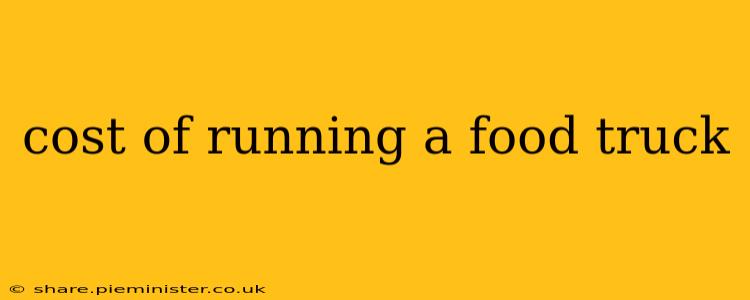Starting a food truck business can be a delicious dream, but it's crucial to understand the significant costs involved before you hit the road. This comprehensive guide breaks down the expenses, offering insights to help you create a realistic budget and plan for success. We'll cover everything from initial investment to ongoing operational costs, addressing common questions food truck entrepreneurs have.
Initial Startup Costs: Getting Your Food Truck Rolling
The initial investment is arguably the most significant hurdle. This includes everything needed to get your truck up and running, before you even sell your first meal.
-
Truck Purchase or Lease: This is your biggest expense. Prices vary wildly depending on the truck's size, age, condition, and features. Expect to spend anywhere from $20,000 to well over $100,000. Leasing can reduce the initial outlay but will increase your ongoing costs.
-
Build-Out and Equipment: Equipping your truck for food preparation is crucial. This includes commercial-grade ovens, refrigerators, freezers, grills, prep tables, sinks, and other essential kitchen equipment. Costs here can easily reach $20,000 to $50,000 depending on your menu and complexity of food preparation.
-
Licensing and Permits: You'll need various licenses and permits at the local, state, and sometimes federal levels. These include business licenses, food service permits, health permits, and potentially others depending on your location and menu. Costs vary significantly by region.
-
Insurance: Food truck insurance is essential to protect your business and assets. This includes liability insurance, property insurance, and potentially other types of coverage.
-
Initial Inventory: Stocking your truck with ingredients, supplies, and packaging is another upfront cost to factor in.
Ongoing Operational Costs: Keeping the Wheels Turning
Once your food truck is operational, a range of ongoing expenses will demand your attention.
-
Rent and Utilities: If you don't own the truck outright, you'll have lease payments. Additionally, you might need storage space, which adds to your rental costs. Utilities like electricity, water, and gas will also be ongoing expenses.
-
Food Costs (COGS): The cost of goods sold (COGS) is a significant portion of your operational budget. This includes all ingredients, packaging, and disposable supplies needed to produce your menu items.
-
Labor Costs: Depending on your staffing needs, labor costs (salaries, wages, benefits) can eat into your profits.
-
Marketing and Advertising: Attracting customers requires a solid marketing strategy. This includes online advertising, social media marketing, print advertising, and potentially event participation fees.
-
Maintenance and Repairs: Regular maintenance and occasional repairs are vital for keeping your food truck operational. Expect costs for mechanical repairs, appliance servicing, and other maintenance tasks.
-
Fuel Costs: The amount you spend on fuel will vary significantly based on your operating area and frequency of travel.
H2: What are the typical monthly expenses for a food truck?
This is highly variable and dependent on many factors such as location, menu, and business model. However, a realistic monthly expense budget might include rent/lease, utilities, food costs, labor, marketing, insurance, and maintenance, totaling anywhere from $5,000 to $15,000 or more.
H2: How much profit can a food truck make?
Profitability depends entirely on your operational efficiency, menu pricing, sales volume, and management of expenses. Some food trucks achieve high profitability, while others struggle. Thorough market research and realistic financial planning are crucial for maximizing your chances of success.
H2: How much does it cost to start a food truck business in my area?
The costs will vary widely depending on your specific location. Permits, licenses, and other regulations differ from state to state and even city to city. Research your local requirements thoroughly, and factor in local costs of living for accurate budget estimation. Speak to local business owners and city officials for current information.
H2: What are the hidden costs of owning a food truck?
Hidden costs can often catch entrepreneurs off guard. These can include unexpected repairs, permit renewal fees, higher-than-expected insurance premiums, and fluctuating food costs. Building a buffer into your budget is prudent to address unforeseen expenses.
Conclusion: Planning for Success
Starting a food truck business requires careful planning and realistic budgeting. By thoroughly researching initial and ongoing costs, you can create a solid financial foundation for your venture. Remember, thorough market research, a well-defined business plan, and efficient management are key factors in achieving profitability and success in the competitive food truck industry.
